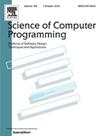Auto-active verification of distributed systems and specification refinements with Why3-do
IF 1.4
4区 计算机科学
Q3 COMPUTER SCIENCE, SOFTWARE ENGINEERING
引用次数: 0
Abstract
In this paper, we introduce a novel approach for rigorously verifying safety properties of state machine specifications. Our method leverages an auto-active verifier and centers around the use of action functions annotated with contracts. These contracts facilitate inductive invariant checking, ensuring correctness during system execution. Our approach is further supported by the Why3-do library, which extends the Why3 tool's capabilities to verify concurrent and distributed algorithms using state machines.
Two distinctive features of Why3-do are: (i) it supports specification refinement through refinement mappings, enabling hierarchical reasoning about distributed algorithms; and (ii) it can be easily extended to make verifying specific classes of systems more convenient. In particular, the library contains models allowing for message-passing algorithms to be described with programmed handlers, assuming different network semantics.
A gallery of examples, all verified with Why3 using SMT solvers as proof tools, is also described in the paper. It contains several auto-actively verified concurrent and distributed algorithms, including the Paxos consensus algorithm.
使用Why3-do对分布式系统和规范进行自动验证
本文介绍了一种严格验证状态机规范安全特性的新方法。我们的方法利用了一个自动激活的验证器,并以使用带有契约注释的操作函数为中心。这些契约促进归纳不变检查,确保系统执行期间的正确性。我们的方法得到了Why3-do库的进一步支持,该库扩展了Why3工具使用状态机验证并发和分布式算法的功能。Why3-do的两个显著特性是:(i)它通过细化映射支持规范细化,支持分布式算法的分层推理;(ii)它可以很容易地扩展,使验证特定类别的系统更加方便。特别是,该库包含允许使用编程处理程序描述消息传递算法的模型,假设不同的网络语义。本文还描述了一系列示例,这些示例都使用SMT求解器作为证明工具与Why3进行了验证。它包含几种自动验证的并发和分布式算法,包括Paxos共识算法。
本文章由计算机程序翻译,如有差异,请以英文原文为准。
求助全文
约1分钟内获得全文
求助全文
来源期刊

Science of Computer Programming
工程技术-计算机:软件工程
CiteScore
3.80
自引率
0.00%
发文量
76
审稿时长
67 days
期刊介绍:
Science of Computer Programming is dedicated to the distribution of research results in the areas of software systems development, use and maintenance, including the software aspects of hardware design.
The journal has a wide scope ranging from the many facets of methodological foundations to the details of technical issues andthe aspects of industrial practice.
The subjects of interest to SCP cover the entire spectrum of methods for the entire life cycle of software systems, including
• Requirements, specification, design, validation, verification, coding, testing, maintenance, metrics and renovation of software;
• Design, implementation and evaluation of programming languages;
• Programming environments, development tools, visualisation and animation;
• Management of the development process;
• Human factors in software, software for social interaction, software for social computing;
• Cyber physical systems, and software for the interaction between the physical and the machine;
• Software aspects of infrastructure services, system administration, and network management.
 求助内容:
求助内容: 应助结果提醒方式:
应助结果提醒方式:


